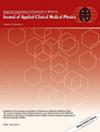Evaluation of image quality in mobile cone-beam CT with dose modulation using automatic exposure control: A phantom study
Abstract
Background
The integration of mobile cone-beam computed tomography (CBCT) into brachytherapy workflows offers clinical advantages such as immediate verification of applicator placement and adaptive treatment planning. These benefits require sufficient image quality to delineate applicators, target volumes, and organs at risk. A systematic evaluation of automatic exposure control (AEC) settings, radiation dose, and image quality is essential to ensure clinically acceptable imaging while minimizing patient exposure.
Purpose
This study evaluates the characteristics of AEC and its impact on image quality and radiation dose in a mobile CBCT system used for brachytherapy.
Methods
The Elekta ImagingRing CBCT system was used to scan a CatPhan phantom under two imaging protocols: Medium Dose Limit (MDL) and Ultra-High Dose Limit (UHDL). This system employs a two-layer mAs modulation process, consisting of preset mA values based on body mass index (BMI) and adjusted mA based on real-time AEC. A bolus was used to simulate larger patient sizes. Real-time x-ray tube current at 10 degrees intervals was recorded. Image quality was evaluated using image noise, noise power spectrum (NPS), modulation transfer function (MTF), Hounsfield Unit (HU) linearity, uniformity index (UI), and contrast-to-noise ratio (CNR) across different protocols.
Results
AEC effectively modulated x-ray tube current in the MDL protocol after x-ray attenuation through the scanned phantom was measured. The UHDL protocol demonstrated greater noise reduction than the MDL. MTF values were comparable between protocols, indicating preserved spatial resolution in the MDL protocol. HU linearity was consistent across all protocols, with R2 > 0.993.
Conclusion
AEC in mobile CBCT optimized radiation dose and image quality by adjusting tube current based on attenuation. The MDL protocol reduced radiation exposure while maintaining image quality, making it a viable option for verifying applicator placement and treatment planning in brachytherapy. The UHDL protocol achieved noise reduction with the maximum available tube current.


 求助内容:
求助内容: 应助结果提醒方式:
应助结果提醒方式:


